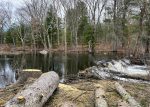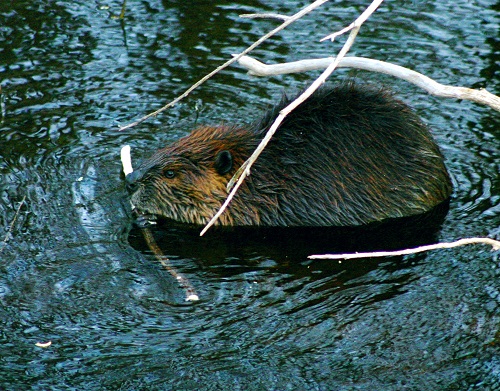Above: A beaver busy at work building a dam (image cropped from photo by Sally Waters)
[This post is part of a special guest series focused on appreciating nature in Southborough, contributed by the Southborough Open Land Foundation (SOLF), a non-profit dedicated to preserving and stewarding natural resources here in town.]
I have a fascination with beavers. I live on the Sudbury River and so do they! They made a dam right behind my house and things began to change. The dam made the river into a pond. I began to hear frogs. Each morning a couple more trees had fallen and the dam got longer and higher. Eventually, from being immersed in water, the trees began to die opening up areas to sunlight that enabled many more species of plants to grow.
Why do beavers build dams? Primarily for safety and access to food. Beavers are really pretty big; up to 60 pounds; approximately that of a seven-year-old human. When we see them swimming, they don’t look so big because we are mostly seeing only their head. But when they climb up and over a dam there is a whole lot of body that follows! That big body with relatively short legs, make them pretty slow-moving on land. In the water, though, they are fast. And they can swim under water for up to 15 minutes.
They build a dam to make a pond so they can safely swim to their food. Their favorites are aquatic plants like the roots and stems of cattails and lilies; tender branches of willow, birch, alder, poplar etc; plus leaves, vines, shrubs and grasses etc. They are herbivores.
Once they have the pond, they begin construction of their home in it. They start by pushing newly chewed branches into the mud or sand at the bottom. They crisscross the sticks and then keep piling them on until the stick pile is way above water. But, at that point, there’s no way in; it’s just a pile of sticks. So, they go down under water and chew their way into the middle of the pile. Then they chew a space to live in. They make two ways for going in or out.
In the fall, with the first hard frost, beavers begin packing the outside of their lodge with mud which will freeze providing a good layer of insulation. They also begin stockpiling food. The areas just above the dam and near the lodge are deeper because of mud taken for the dam and for “insulation.” Into that area are put fresh young branches of shrubs and trees; stuck into the bottom and then loosely piled. Beavers do not hibernate; they are active all winter.
 Beavers annoy humans because they flood wetlands, but this can be both good and bad. It is “bad” for people who live near or in a wetland because of course, a beaver pond can jeopardize an old septic system or create a rather soggy lawn as well as flood some small roads etc. Rather than trapping beavers a more effective and longer-term solution is to install a flow control device sometimes known as a “Beaver Deceiver” as I did in the dam near me. This is basically a pipe installed in a dam that will create a permanent leak that they cannot access. This maintains a specific level of water. It is carefully designed for each specific location taking into consideration the depth and flow of the stream.
Beavers annoy humans because they flood wetlands, but this can be both good and bad. It is “bad” for people who live near or in a wetland because of course, a beaver pond can jeopardize an old septic system or create a rather soggy lawn as well as flood some small roads etc. Rather than trapping beavers a more effective and longer-term solution is to install a flow control device sometimes known as a “Beaver Deceiver” as I did in the dam near me. This is basically a pipe installed in a dam that will create a permanent leak that they cannot access. This maintains a specific level of water. It is carefully designed for each specific location taking into consideration the depth and flow of the stream.
Beavers are also beneficial! A beaver dam slows the water flow allowing sediment and some pollutants to settle at the bottom. Slower water that has spread over a larger area helps to recharge underground aquifers and also prevents more serious flooding downstream in periods of heavy rain. Beaver ponds create a habitat for many more species than a river would. For nature lovers, a beaver pond provides much to see and enjoy. The standing dead trees provide perfect nesting for bluebirds, wood ducks, woodpeckers, great blue herons and tree swallows to name a few. Great Blue Herons slowly wade or stand statue-like hunting for frogs and small fish. Muskrats, often mistaken for beavers, though much smaller, toodle around carrying grass and rushes to their young; deer can easily be watched slowly grazing through the sedges and low shrubs. Kayaking slowly in a beaver pond is bliss.
Myths about beavers:
- They do not use their tails to pack down mud on their dams.
- They do not build lodges on docks or floats.
- They do not live in their dams.
Love ‘em or hate ‘em, there’s so much to learn about the fascinating beaver. Available books include “Eager” by Ben Goldfarb and “Beaverland” by Leila Philip. (Caution: Sadly, there are sometimes inaccuracies in children’s books about beavers that prolong the myths.)
There are fascinating documentaries including “Leave it to Beavers.” There are several with David Attenborough of the BBC, including: https://youtu.be/iyNA62FrKCE
I highly recommend all the information and resources listed at www.beaversolutions.com
Want to learn more about SOLF, or volunteer or donate? Check out our site, we’d love to hear from you.
Deborah Costine,
SOLF trustee, artist and nature enthusiast
Visit SOLF.org and find us on Facebook



I’ve seen evidence of tree-cutting by beavers around the Sudbury Reservoir here: https://goo.gl/maps/RPHckGQnqpKSrGGr7. But I haven’t found a lodge nearby.
Don’t understand the behavior you report. Because beavers typically cut down trees for food, for building dens and for building dams to stop flowing water in streams.
But there is no water flowing fast in our resevoir. So how do you explain this ?
I’m no expert, but if the two-legged engineers already built a dam, why shouldn’t the four-legged engineers take advantage of that?